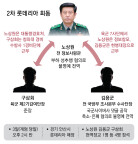Rea Unknown Japanese Worker Won Nobel Prize
Rea Unknown Japanese Worker Won Nobel Prize
Posted October. 10, 2002 22:48,
At around 6:15 p.m. on Oct. 9th, Koichi Tanaka (43), a researcher at Shimadzu Corporation, got surprised to receive an unexpected long distance phone call. As usual, he was immersed in his research, while his colleagues were busy wrapping up the day. Then, the Royal Swedish Academy notified him that he is one of the three joint winners of the Nobel Prize in Chemistry.
lly? Did I win the Nobel Prize?
Soon an army of domestic and foreign reporters stormed his company. But in the press conference, he humbly said, Im sorry for still in lab uniforms. I cant believe this. How could I have won the Nobel Prize. I am not a professor or a scholar!
Actually, he is the first winner of the prize, who does not have a Ph.D. All he has is a B.S. in electronics from one of those schools in Tokyo, not Tokyo University. On top of this, he first encountered chemistry when he got a job at Shimadzu Corporation.
The chemistry scholars of Japan got perplexed to watch an unknown worker receive the Nobel Prize. But most of the Japanese praise him. They value Tanakas development of protein-analysis methods (formally, development of soft desorption ionisation methods for mass spectrometric analyses of biological macromolecules), which can detect in early stage the breast cancer and the prostate cancer. They also think highly of the judges of the Nobel Prize who cherished more of a persons achievement than his educational or other backgrounds.
Once he gets himself delved in a research, he often shaves his hair because it feels cumbersome to wash his hair, which has earned him nicknames like Wierdo or Studying worm. But for his winning, luck seems to have played a part.
When analyzing protein with laser, the protein gets ionized and dispersed if laser is projected on it without any treatment. In order to prevent this, some additive is necessary. For that purpose, Tanaka had kept using glycerin or cobalt as the additive in his experiments. One day, he mistakenly dropped glycerin onto cobalt. But, at the very moment, he got inspired and thought of using the mixture of them in his experiment. He put his idea into practice, which led to the great success in experiment.
His name got to be known by a German chemistry scholar. The scholar cited in his paper the analytical method developed by Tanaka.
Ever since his joining Shimadzu Corporation in April of 1983, he has mainly engaged in development of analyzing devices for genes and proteins. Shimadzu Corporation, which has its headquarters in Kyoto, started its history in 1875 as a company manufacturing chemistry instruments for school classes. Now it has secured itself as one of the main manufacturers of various kinds of cutting-edge instruments, producing measuring devices, medical, aircraft and industrial equipment; and developing related technology.
hanscho@donga.com
Headline News
- Pres. Yoon refuses impeachment documents for a week
- Debate over Lee’s participation causes friction in government consultative body
- Food and dining prices could increase en masse next year
- Foreign couple borrowed over $2 million to buy a Seoul house
- One-third of Japanese companies keep workers employed until 70







